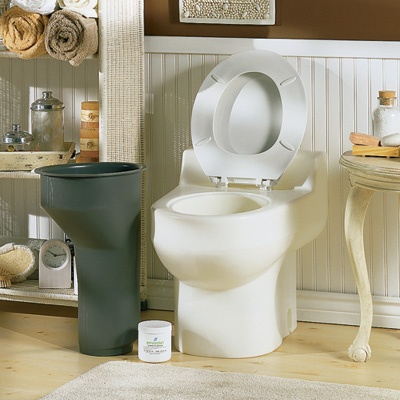A Composting Toilet for Environmentally-Friendly Human Waste Disposal

As early as 1939, Rikard Lindstrom made a composting toilet in order to stop polluting the Baltic Sea, and today, people use the toilets for camping, boats and survival shelters. However, some claim that to preserve our water resources, we need to accept an option other than flushing away bodily wastes with clean drinking water.
Waste Composting Requirements
Western society considers human feces waste products as toxic and frankly, microorganisms within feces can cause potentially fatal illnesses such as hepatitis, cholera and typhoid. However, under the right conditions, other microorganisms will eliminate the toxins, and turn the waste into nutrient rich soil.
In order for microorganisms to turn human waste into harmless, nutrient rich compost, you need:
- Nitrogen
- Carbon
- Oxygen
- Moisture
- Heat
Human waste is filled with nitrogen but composting requires large amounts of carbon, so you need carbon sources such as grass clippings, wood chips or leaves to provide the balance. Covering the waste with wood chips or peat moss not only provides the needed carbon, it helps to control the odor, as excess nitrogen will form ammonia gas.
The compost pile needs oxygen, moisture and heat but you need to regulate the heat and moisture, as too much of either will kill those helpful microorganisms. A means to drain the urine from solid waste is necessary, and a heater is sometimes to keep the optimal temperature for composting.
Other Considerations
You need to plan for the number of people that will use the composting toilet and how long you expect to use it. Composting is a process that requires time so you need a very different system to handle the waste of a large group of people daily from a system that will service a couple of people for short periods of time.
You also need to consider the climate where you are using it. In arid climates, you need a means to water the compost and in northern locations a means to keep the compost from freezing. The microbes can survive drying out or freezing, but they will stop processing the waste into compost in extreme conditions.
Composting Toilet System
The basic components of the environmentally friendly toilet are:
- Toilet seat and conduit to the storage tank
- Container/storage tank to collect the waste
- Vent to remove the by-products of composting
- Ventilation to provide oxygen
- Drain to remove excess liquid such as urine
- Door to remove the compost
It does take some skill to build this type of toilet, but it is possible to purchase instruction books for about $20 or $30 dollars on Amazon. Starting at $900, you can purchase toilets ready to use that will service one or two people for a three to four week period before you have to empty it.
Advantages of Composting Waste
A composting toilet in your survival shelter is a good option because you can leave the toilet for long periods of time, if you are not using it. It is far less expensive to obtain and maintain than a septic tank system and this type of toilet completes the circle of life. You eat products from the earth, the body processes the food, eliminates the unusable by products, which goes back to the earth.
Disadvantages of Composting Waste
Foul odors occur if the system is not installed properly, and if the waste is not processed completely, you will face serious if not fatal illnesses. When using this system you need to monitor the composting and you may need to heat the compost to 160 degrees Fahrenheit or 70 degrees Celsius to kill pathogens. You also need to dispose of the liquid waste, which many people process with a gray water system.
The composting toilet is a viable option for handling human waste but it requires a commitment to ensuring the system is working correctly and access to plant materials such as leaves, wood chips or other organic materials. It is not necessarily the easiest method for fixing in place in an urban setting for long periods of time, but in a rural setting it certainly could be a viable option.
Return from Composting Toilet to Survival Sanitation





New! Comments
Have your say about what you just read! Leave me a comment in the box below.